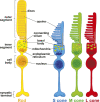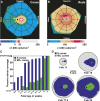Patterning and Development of Photoreceptors in the Human Retina
- PMID: 35493094
- PMCID: PMC9049932
- DOI: 10.3389/fcell.2022.878350
Patterning and Development of Photoreceptors in the Human Retina
Abstract
Humans rely on visual cues to navigate the world around them. Vision begins with the detection of light by photoreceptor cells in the retina, a light-sensitive tissue located at the back of the eye. Photoreceptor types are defined by morphology, gene expression, light sensitivity, and function. Rod photoreceptors function in low-light vision and motion detection, and cone photoreceptors are responsible for high-acuity daytime and trichromatic color vision. In this review, we discuss the generation, development, and patterning of photoreceptors in the human retina. We describe our current understanding of how photoreceptors are patterned in concentric regions. We conclude with insights into mechanisms of photoreceptor differentiation drawn from studies of model organisms and human retinal organoids.
Keywords: cone; human; macula; photoreceptor; retina; retinoic acid; rod; thyroid hormone.
Copyright © 2022 Hussey, Hadyniak and Johnston.
Conflict of interest statement
The authors declare that the research was conducted in the absence of any commercial or financial relationships that could be construed as a potential conflict of interest.
Figures






References
-
- Agte S., Savvinov A., Karl A., Zayas-Santiago A., Ulbricht E., Makarov V. I., et al. (2018). Müller Glial Cells Contribute to Dim Light Vision in the Spectacled caiman ( Caiman crocodilus Fuscus ): Analysis of Retinal Light Transmission. Exp. Eye Res. 173, 91–108. 10.1016/j.exer.2018.05.009 - DOI - PMC - PubMed
Publication types
LinkOut - more resources
Full Text Sources

